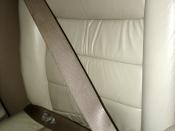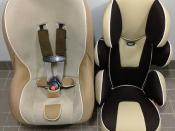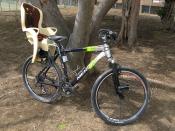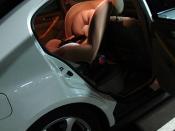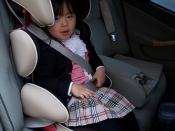Journal- Child:
"Use of Child Booster Seats in Motor Vehicles Following a Community Campaign"
Child booster seats are designed to improve safety for children who are too big for a traditional child harness seat but who are too small to properly use an adult seat belt. Usually these children are between four and eight years old and weigh between 18 and 36 kg. The purpose of this study is to determine if a community centric campaign would improve the rate of child booster seat usage among those children who would benefit from a booster seat.
Motor vehicle accidents are a leading cause of death of children age 4-8 however booster seat usage remains low. This study uses a community advertising campaign modeled on a campaign to increase bicycle helmet usage among children. Four communities in the Seattle, WA area were selected for the campaign and eight communities in the Portland OR, and Spokane WA areas were selected as control groups.
The rate of booster seat usage was observed in all communities before and after the campaign.
The goal of the campaign was to educate parents on the necessity of child booster seats. Many parents mistakenly believe that an adult seatbelt provides adequate protection after the child is big enough to no longer require a harness seat. A coalition was formed that included health providers, educators, and law enforcement officials. A toll free hotline and website were set up to answer parent's questions. Additionally by partnering with a booster seat manufacture, parents could be provided with coupons to reduce the price of booster seats to under $20.
To carry out the study, seat belt and booster seat usage was observed in parking lots where cars carrying local children were likely to be found. Only children large enough to no longer require a child harness seat and also younger than eight years old or weighing less than 36 kg were considered. Among the communities exposed to the campaign, booster seat usage rose from 13.3% to 26.1%. In the control communities, booster seat usage rose from 17.3% to 20.1%. However it's important to note that results varied widely by neighborhood and that in several of the control groups usage actually went down.
The article authors admit that the study was highly localized and the results might not be reproducible outside of the pacific northwest. The choice of Portland, OR communities for part of the control group is curious. All other communities were in Washington state. There is no discussion of the differences in booster seat laws between Washington and Oregon. The article does state "A new booster seat law served as an important reinforcing factor. " However, there was no discussion as to what the law required. It would be helpful to know whether there is any difference in the age or weight groups required by law to use booster seats and the age and weight groups of the children that were studied.
The article states that during the time period of the studied campaign there was also a national campaign to increase booster seat usage conducted by the National Highway Traffic Safety Administration. Its expected that both the experimental and control communities were exposed to this national campaign. Presumably this accounts for some of the increase in booster seat usage in the control communities. However the local campaign provided a much greater increase. This shows the importance of localized advertising. The local campaign probably benefited from the participation of a diverse coalition. Some additional discussion of the differences between the local and national campaigns would be helpful. If the national campaign did not include coupons as the local campaign did then they were probably another significant factor.
The study also observed seat belt usage among the drivers. It's disturbing that only 83% of the observed drivers wore their seat belt. Unfortunately the article does not mention whether any children were observed without a seat belt or booster seat. Seat belt use is important but it wasn't focused on during the advertising campaign so it is not surprising that there wasn't much difference in seat belt usage before and after the campaign.
There was a large amount of variance in booster seat usage from community to community and the study does not attempt to determine why this is. One control community had an increase in booster seat usage fro 21.1% up to 53.8%. This was by far the largest increase and the only community in the study to achieve a 50% usage rate. The control communities had changes ranging from -7.5% up to 32.7%. However, the second largest change in the control communities was only 6.7%. The experimental communities were more consistent with changes ranging from 10.5% to 15.4%. Some of the variance in the control group is probably due to the fact that it included communities in different states. This still doesn't explain why one community had such a remarkably large uptake in booster seat usage and neighboring communities did not.
This study shows that a community based advertising campaign can result in a significant improvement in child booster seat usage. An important aspect of this campaign is the cooperation of law enforcement, educators, and medical professionals. By using a locally focused advertising campaign, the organizers were able to achieve more than double the effectiveness of national campaigns or mandatory booster seat laws.
This Journal is important to me since I hope to be a mother in the future, and I want to make sure my children are safe. I also believe this article helped me because I have nieces and nephews to worry about as well.
References
Ebel, Beth E. et al.. "Use of Child Booster Seats in Motor Vehicles Following a Community Campaign" Journal of American Medical Association. Vol 289. No 7. February 19, 2003. pp 879-884.
